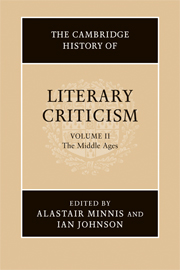Book contents
- Frontmatter
- Introduction
- I THE LIBERAL ARTS AND THE ARTS OF LATIN TEXTUALITY
- II THE STUDY OF CLASSICAL AUTHORS
- III TEXTUAL PSYCHOLOGIES: IMAGINATION, MEMORY, PLEASURE
- IV VERNACULAR CRITICAL TRADITIONS: THE EARLY MIDDLE AGES
- 9 Medieval Irish literary theory and criticism
- 10 Anglo-Saxon textual attitudes
- 11 Literary theory and practice in early-medieval Germany
- 12 Literary criticism in Welsh before c. 1300
- 13 Criticism and literary theory in Old Norse-Icelandic
- V VERNACULAR CRITICAL TRADITIONS: THE LATE MIDDLE AGES
- VI LATIN AND VERNACULAR IN ITALIAN LITERARY THEORY
- VII BYZANTINE LITERARY THEORY AND CRITICISM
- Bibliography
- Index
- References
13 - Criticism and literary theory in Old Norse-Icelandic
from IV - VERNACULAR CRITICAL TRADITIONS: THE EARLY MIDDLE AGES
Published online by Cambridge University Press: 28 March 2008
- Frontmatter
- Introduction
- I THE LIBERAL ARTS AND THE ARTS OF LATIN TEXTUALITY
- II THE STUDY OF CLASSICAL AUTHORS
- III TEXTUAL PSYCHOLOGIES: IMAGINATION, MEMORY, PLEASURE
- IV VERNACULAR CRITICAL TRADITIONS: THE EARLY MIDDLE AGES
- 9 Medieval Irish literary theory and criticism
- 10 Anglo-Saxon textual attitudes
- 11 Literary theory and practice in early-medieval Germany
- 12 Literary criticism in Welsh before c. 1300
- 13 Criticism and literary theory in Old Norse-Icelandic
- V VERNACULAR CRITICAL TRADITIONS: THE LATE MIDDLE AGES
- VI LATIN AND VERNACULAR IN ITALIAN LITERARY THEORY
- VII BYZANTINE LITERARY THEORY AND CRITICISM
- Bibliography
- Index
- References
Summary
- Type
- Chapter
- Information
- The Cambridge History of Literary Criticism , pp. 345 - 460Publisher: Cambridge University PressPrint publication year: 2005



